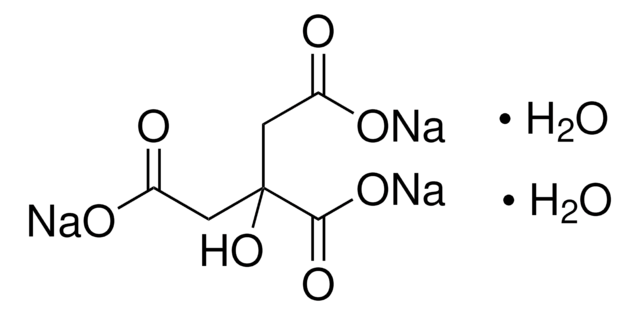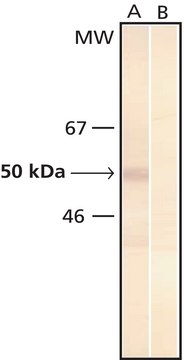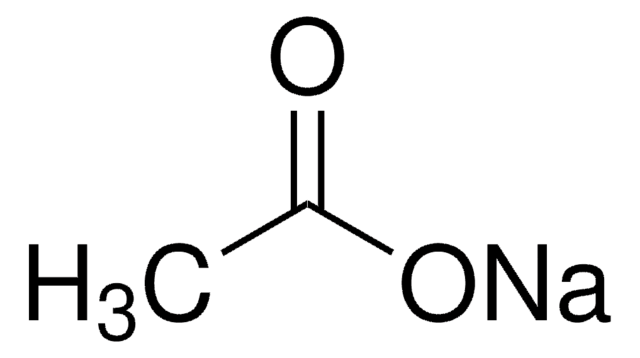推荐产品
生物来源
rabbit
质量水平
抗体形式
affinity isolated antibody
抗体产品类型
primary antibodies
克隆
polyclonal
种属反应性
rat, human, mouse
技术
immunocytochemistry: suitable
immunofluorescence: suitable
immunohistochemistry: suitable
immunoprecipitation (IP): suitable
western blot: suitable
NCBI登记号
UniProt登记号
运输
ambient
靶向翻译后修饰
unmodified
基因信息
mouse ... Cep290(216274)
一般描述
Centrosomal protein of 290 kDa (UniProt: Q6A078; also known as Cep290; Bardet-Biedl syndrome 14 protein homolog; Nephrocystin-6) is encoded by the Cep290 (also known as Kiaa0373, Nphp6) gene (Gene ID: 216274) in murine species. Cep290 is a centrosomal protein that is expressed in multiple organs during early postnatal development, with highest levels in the hindbrain region. Cep290 has 13 putative coiled-coil domains, a region with homology to SMC chromosome segregation ATPases, six KID motifs, three tropomyosin homology domains and an ATP/GTP binding site motif. Cep290 is part of the tectonic-like complex, which is required for tissue-specific ciliogenesis and may also regulate ciliary membrane composition. It is also required for the correct localization of ciliary and phototransduction proteins in retinal photoreceptor cells. Defects in Cep290 gene are known to cause Leber congenital amaurosis (LCA), an early-onset retinal degenerative disease. Mutations in Cep290 gene are also known to cause Joubert syndrome that is characterized by psychomotor delay, hypotonia, ataxia, oculomotor apraxia and neonatal breathing abnormalities.
特异性
This polyclonal antibody detects centrosomal protein of 290 kDa in HEK293 cells.
免疫原
His-tagged recombinant fragment corresponding to 80 amino acids from the C-terminal half of mouse Centrosomal protein of 290 kDa.
应用
Anti-CEP290, Cat. No. ABN1710, is a highly specific rabbit polyclonal antibody that targets Centrosomal protein of 290 kDa and has been tested in and Immunocytochemistry, Immunofluorescence, Immunohistochemistry, Immunoprecipitation, and Western Blotting,
Western Blotting Analysis: A representative lot detected CEP290 in transfected HEK293 cells (Rachel, R.A., et. al. (2012). J Clin Invest. 122(4):1233-45) and COS-1 cells (Chang, B., et. al. (2006). Hum Mol Genet. 15(11):1847-57).
Immunoprecipitation Analysis: A representative lot detected CEP290 in WT and rd16 retinal extract(Chang, B., et. al. (2006). Hum Mol Genet. 15(11):1847-57).
Immunohistochemistry Analysis: A representative lot detected CEP290 in WT mouse retina (Chang, B., et. al. (2006). Hum Mol Genet. 15(11):1847-57).
Western Blotting Analysis: 1:1,000-1:2,000 dilution from a representative lot detected CEP290 in mouse retina (Courtesy of Dr. Tiansen at NIH).
Immunofluorescence Analysis: A representative lot detected CEP290 in ciliated sensory cells (Rachel, R.A., et. al. (2012). J Clin Invest. 122(4):1233-45) and WT mouse retina (Chang, B., et. al. (2006). Hum Mol Genet. 15(11):1847-57).
Immunofluorescence Analysis: 1:500-1:2,000 dilution from a representative lot detected CEP290 in frozen mouse retina (Courtesy of Dr. Tiansen at NIH).
Immunocytochemistry Analysis: A representative lot detected CEP290 in IMCD-3 cells (Chang, B., et. al. (2006). Hum Mol Genet. 15(11):1847-57).
Immunoprecipitation Analysis: A representative lot detected CEP290 in WT and rd16 retinal extract(Chang, B., et. al. (2006). Hum Mol Genet. 15(11):1847-57).
Immunohistochemistry Analysis: A representative lot detected CEP290 in WT mouse retina (Chang, B., et. al. (2006). Hum Mol Genet. 15(11):1847-57).
Western Blotting Analysis: 1:1,000-1:2,000 dilution from a representative lot detected CEP290 in mouse retina (Courtesy of Dr. Tiansen at NIH).
Immunofluorescence Analysis: A representative lot detected CEP290 in ciliated sensory cells (Rachel, R.A., et. al. (2012). J Clin Invest. 122(4):1233-45) and WT mouse retina (Chang, B., et. al. (2006). Hum Mol Genet. 15(11):1847-57).
Immunofluorescence Analysis: 1:500-1:2,000 dilution from a representative lot detected CEP290 in frozen mouse retina (Courtesy of Dr. Tiansen at NIH).
Immunocytochemistry Analysis: A representative lot detected CEP290 in IMCD-3 cells (Chang, B., et. al. (2006). Hum Mol Genet. 15(11):1847-57).
质量
Evaluated by Western Blotting in HEK293 cell lysate.
Western Blotting Analysis: 1:500 dilution of this antibody detected CEP290 in 10 µg of HEK293 cell lysate.
Western Blotting Analysis: 1:500 dilution of this antibody detected CEP290 in 10 µg of HEK293 cell lysate.
目标描述
~260 kDa observed; 289.08 kDa calculated. Uncharacterized bands may be observed in some lysate(s).
外形
Format: Purified
其他说明
Concentration: Please refer to lot specific datasheet.
未找到合适的产品?
试试我们的产品选型工具.
储存分类代码
10 - Combustible liquids
WGK
WGK 2
法规信息
新产品
Poppy Datta et al.
The Journal of biological chemistry, 294(50), 19119-19136 (2019-11-07)
Mutations in the centrosomal protein 290 (CEP290) gene cause various ciliopathies involving retinal degeneration. CEP290 proteins localize to the ciliary transition zone and are thought to act as a gatekeeper that controls ciliary protein trafficking. However, precise roles of CEP290
我们的科学家团队拥有各种研究领域经验,包括生命科学、材料科学、化学合成、色谱、分析及许多其他领域.
联系技术服务部门




